Dorset, England
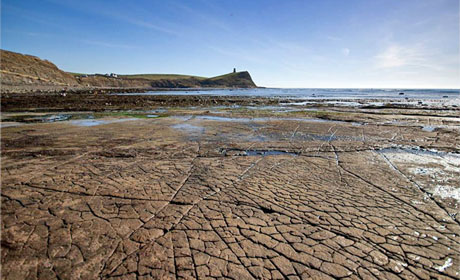
'More Kimmeridge Bay #100geosites:
This time, amazing fault-propagation folds emerging in the platform'
From Jorge @lithospheric
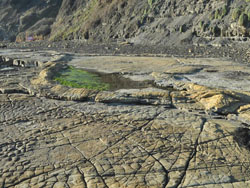 Kimmeridge Bay is the type locality for the Jurassic age Kimmeridge Clay formation, and provides one of the source rocks for hydrocarbons found in the Wessex and North Sea Basins. The village of Kimmeridge stands on Jurassic shale cliffs, and gives its name to the Kimmeridgian, the division of the Jurassic period in which the beds were laid down.
Kimmeridge Bay is the type locality for the Jurassic age Kimmeridge Clay formation, and provides one of the source rocks for hydrocarbons found in the Wessex and North Sea Basins. The village of Kimmeridge stands on Jurassic shale cliffs, and gives its name to the Kimmeridgian, the division of the Jurassic period in which the beds were laid down.
Laid down 155 million years ago, the rocks at Kimmeridge Bay were once the floor of a deep, tropical sea rich in pre-historic life. Today they form just part of the 95 miles of Dorset and East Devon Coast designated as a geological World Heritage Site, known as the Jurassic Coast, and containing a unique record of the entire Mesozoic Era.
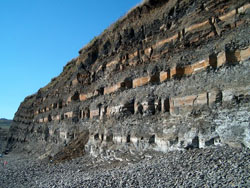 The cliffs and foreshore contain a very thick sequence of Kimmeridge Clay, which is excellently exposed, particularly at low tides, in a rhythmic succession of mudstones, thin shales and resistant yellow-brown dolomites, the so-called stone bands.
The cliffs and foreshore contain a very thick sequence of Kimmeridge Clay, which is excellently exposed, particularly at low tides, in a rhythmic succession of mudstones, thin shales and resistant yellow-brown dolomites, the so-called stone bands.
The rock layers are like the pages in a book and the fossils they contain tell a story on each page. Each rock layer provides a window allowing us to look back through geological time. The sequence of rocks here provides such an excellent record of this part of the Jurassic that geologists have adopted Kimmeridgian as the term for rocks of this age all around the world.
Important fossils have been found in the Kimmeridge Clay, but they need an expert eye and time-consuming preparation. Some of the shales contain enough organic matter to be classed as oil shales. Flattened ammonites are abundant in some of the shale horizons and include specimens of Pectinatites, Aulacostphanus and Subdichotomoceras. Bivalves and brachiopods are also common.
The beach platform and cliffs are within an SSSI, so hammering is strictly forbidden here and you may only collect loose fossils from the beach.
Rocky Ledges
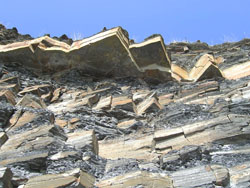 Harder bands of limestone within the Kimmeridge Clay create a series of rocky ledges that run out to sea. As a result, the Bay boasts some of the most accessible marine wildlife in the UK. The stone ledges make it easy to view life on the shore an in the shallow waters, and there is safe snorkelling for the more adventurous.
Harder bands of limestone within the Kimmeridge Clay create a series of rocky ledges that run out to sea. As a result, the Bay boasts some of the most accessible marine wildlife in the UK. The stone ledges make it easy to view life on the shore an in the shallow waters, and there is safe snorkelling for the more adventurous.
Kimmeridge Bay is part of the Purbeck Marine Wildlife Reserve, managed by the Dorset Wildlife Trust. The Trust runs the Fine Foundation Marine Centre in the bay, providing an exhibition, aquarium and a programme of events.
Oil in the rocks
The horizons around the bay form part of an anticline with very shallow dips and in 1959 drilling in the area revealed a small oil reservoir at depth in the Cornbrash Formation. Since the 1960s there has been a nodding donkey extracting oil on the cliff top at the west side of the bay. BP's ‘nodding donkey' on the cliff top has been producing oil ever since. At its peak the well was producing 350 barrels a day but current production is no more than 65 barrels a day.
The oil formed in rocks that were laid down on a stagnant sea floor. The rocks were buried and organic matter within them was ‘cooked' to form oil and gas. More oil lies in the northern part of Purbeck, and under Poole Harbour. This is the Wytch Farm Oilfield - the largest onshore oil field in the UK. It is difficult to see the carefully landscaped oil wells.
The geology of an oil field
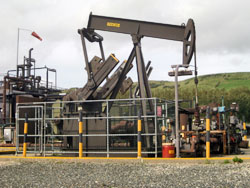 Oil fields form where the structure of the rocks creates a trap for oil generated in the rocks below. At Kimmeridge the oil is held in the layer of rock called the Cornbrash Limestone which can also be found around Osmington Mills.
Oil fields form where the structure of the rocks creates a trap for oil generated in the rocks below. At Kimmeridge the oil is held in the layer of rock called the Cornbrash Limestone which can also be found around Osmington Mills.
An exciting development nearby is the Heritage Lottery funded Steve Etches Collection and Museum of Jurassic Marine Life project to create a purpose built museum and community space to house the remarkable collection of Kimmeridgian fossils created by Steve Etches, who lives in Kimmeridge. Read more details on this project in the links to the right.
Text courtesy of Jurassic Coast Dorset and East Devon World Heritage Site and Howard Colley
Nominated by: @lithospheric (twitter), Mark Godden (Facebook)